Escaping Time: An Interview with Thorsten Fleisch
By Clint Enns
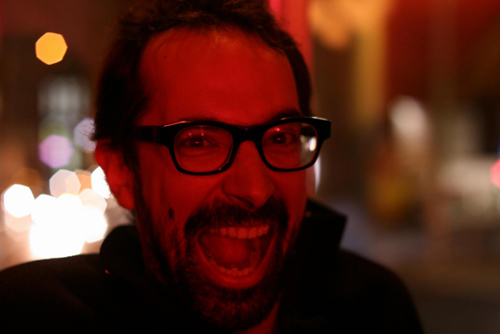
The Berlin-based artist Thorsten Fleisch began making films in high school. His work has been well received almost from that very start, garnering prestigious awards such as the Ann Arbor Film Coop Award. Personally, I was first attracted to the inherently high concept / low budget nature of his projects. I was also intrigued by his use of, and interest in, mathematics. Recently, Fleisch has crossed-over into more mainstream assignments, creating the titles for Gasper Noé’s feature film Enter the Void (2009) and visuals for Basement Jaxx’s 2009 live tour. Meanwhile, Fleisch’s latest experimental film, Dromosphäre (2010), is among the best I have seen in the last few years.
* * *
CE: Your work seems influenced by Austrian experimental film sensibilities–from the use of the human body and fluids to the employment of systemic and mathematical structures. Is this a result of studying with Peter Kubelka? What were some of your other influences?
TF: Before studying with Kubelka I was really into the Viennese Actionists, especially [Hermann] Nitsch. He was a major influence on my film Bloodlust (1998). I remember seeing one of his blood paintings in a museum; the effect it had on me was very intense. I didn't know a lot about Austrian filmmakers before that but I had read about Kurt Kren who filmed some of Otto Muehl’s performances. This was before the Internet, YouTube, UbuWeb–a time when it was difficult to access those films. I had seen some Brakhage and Martin Arnold on TV–at that time, German TV was much more daring in its programming–which also had an influence on me.
While studying with Kubelka I got exposed to a lot more Austrian and American avant-garde films, which was great. I was in his class for two years in the late-90s. It was a great experience. He had a very strong presence and was always telling interesting anecdotes from his time in the U.S. He had so many stories about experimental film celebrities. In addition to being an exceptional filmmaker, he is also a renowned storyteller and performer. It really was a decent time. Although, I have to admit that I didn't really connect with the other students, except for Goh Harada, who is still a dear friend. I felt like I was on a strange isolated island. My favorite memory from film school was our trip to Vienna for a show called “Film ist” (“Film is”) which Peter had curated. It was about ten days filled with awesome programs of experimental films screened in a wonderful cinema from pristine prints.
I first encountered a structural approach in music. Around 1994-95, I finished my first CD release, which nobody seemed interested in at the time. I was working with sequencers to produce my music. I assume that shaped my perception of structure and contributed to my use of it in film.
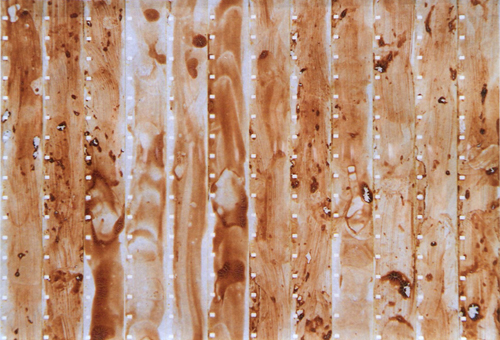
Filmstrips from Bloodlust / Thorsten Fleisch
CE: In Bloodlust you apply your own blood onto 16mm clear leader. How much blood did it take to make the film, and do you ever screen the original 16mm version? Has the film changed over time?
TF: It didn’t take that much blood, maybe like 0.05 litres. For the first few meters of film, I used blood collected from nosebleeds. I really liked the results. When that blood was gone I obtained three vials taken with a syringe from a nurse. I never intended to screen the original. I projected it at home to see what it would look like; after that, it was viewed only on a flatbed editor. Blood always ended up coming off. When it screened at Ann Arbor in 2000, I made business cards that included pieces from the original film strip. I only have a few left. In general, I think the colour has become a bit weaker and maybe a bit more yellow or brown, too.
CE: Bloodlust is also interesting conceptually, in its allusion to cinema’s inherent violence. Even the language for filmmaking is violent: We shoot with a camera to capture an image. Do you feel you were addressing something similar in Kamerazerfetzer (Camera Annihilator) (1998) and Flexcam (1998)–two films in which you destroy super 8 cameras while they are running for “the sake of science.”
TF: This destructive output is mostly the result of an instinct driven impulse. I don’t really think about the implications of destroying things, I just have the urge and the curiosity to do it. One of the great things about being an artist is giving in to urges. I’m not really a violent person, quite the contrary, but I admit that I like destruction–or at least the abstract or sensual notion of destruction. I guess there are two sides to it–one is the power aspect and the other is the curiosity of pulling something apart to see what’s inside, which is the essence of scientific inquiry. To understand how a mechanism or an organism works, one must destroy it in order to peek inside.
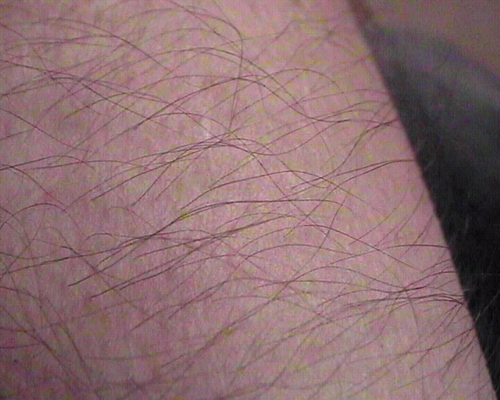
Videoskin / Thorsten Fleisch
CE: In works like Videoskin (2001), Skin Sketches (1998) and Skin Flick (2002) you mediate on or examine human skin. Where does your fascination with skin (and wounds) stem from?
TF: I like scars. Wounds not so much; however, they are interesting since they reveal the inside of our bodies. They are also considered taboo, since we are intrinsically not supposed to see them. I have always been interested in the insides of our bodies. I really liked splatter films as an adolescent. I still watch them occasionally, but only the old ones. I dislike how the horror genre has evolved. I’m actually writing a script at the moment that falls into the science fiction horror genre– of course it will involve some more experimental elements. I also really liked the cover art for the early Carcass albums. They were a collage of wounds taken from a medical atlas. In high school, I was inspired by their cover art. I even designed a notebook using photos of wounds, violent deaths and tabloid headlines of bizarre and violent crimes. I still have it.
CE: In Videoskin, you document the hair on your skin while watching the film Once Upon a Time in the West (Sergio Leone, 1968). In your synopsis for this work you explain that it is an attempt to “ examine the effects of feeling inducing rays transmitted by a VCR driven TV screen.” Do you believe that the “rays transmitted by a VCR driven TV screen” actually caused the goose bumps ? Did you consider this piece to be a scientific investigation?
TF: Well, sort of, but it is also intended to be tongue-in-cheek. I find it fascinating that this box of wires, resistors and capacitors with current running through it can cause genuine emotion. The same could be said about books and paintings. The film serves as a document of that process, that is, it documents emotions generated by a machine.
CE: However, it isn’t really the device that is causing the emotional reaction; it is the content of the images. Similarly with books and paintings: It isn’t the paint that causes us to feel something, it is the artists’ use of paint.
TF: That's true, but I wanted to look at the television as a technical apparatus that produces emotions without acknowledging that the human mind adds content. This thought appeals to me. What would an alien think about the sight of a human reacting emotionally to a machine? I think in the not-so-distant future, we will have robot pets that we will react emotionally to. This man/machine interaction fascinates me.
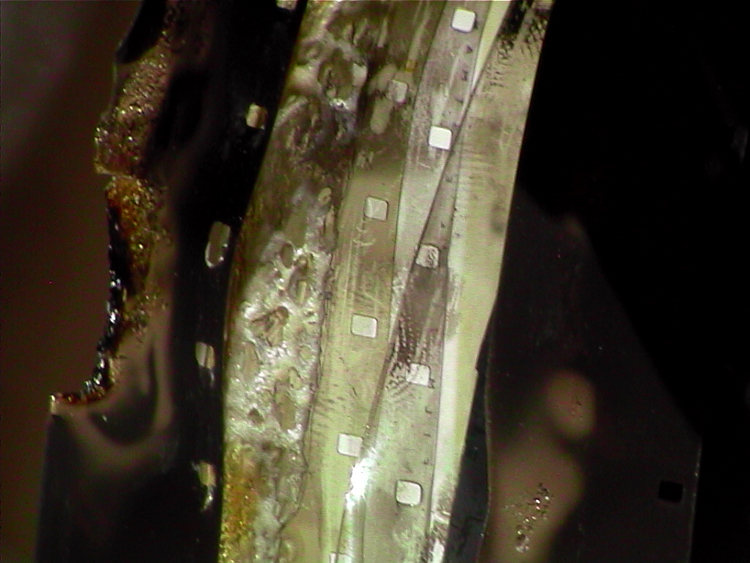
Documentation for Open Fire / Thorsten Fleisch
CE: In The Anti-Movie (1997), you manipulated black leader in order to make it unprojectible. In Open Fire (1998), you burnt clear and black leader, thereby creating a beautiful-but unscreenable–art object. Do you feel these are still “films” despite the fact they are unplayable? Is Friendly Fire (2003)–a film in which images of fire burn the film itself–an extension of Open Fire?
TF: Friendly Fire is more like an interpretation or application of Open Fire. In a way, Friendly Fire is the same as Open Fire but applied to a projector, or more precisely to an optical printer.
Conceptually, Open Fire and The Anti-Movie are films despite being unplayable, but in reality, they function as objects. In fact, a film is an actual object. This is not the case with digital media. Digital images are shape-shifting; they are like ghosts.
CE: You mean digital images are simply information that allows the images to change physical form.
TF: Yes, pragmatically speaking that’s true; however, as before when we talked about Videoskin, I like to view things with a naïve gaze. Maybe my fascination for this naïve gaze at technology and information shares a similarity with Brakhage's theory of seeing.
Imagine an eye unruled by man-made laws of perspective, an eye unprejudiced by compositional logic, an eye which does not respond to the name of everything but which must know each object encountered in life through an adventure of perception. How many colors are there in a field of grass to the crawling baby unaware of 'Green'? How many rainbows can light create for the untutored eye? How aware of variations of heat waves can that eye be? Imagine a world alive with incomprehensible objects and shimmering with an endless variety of movement and innumerable gradations of color. Imagine a world before the “beginning was the word.”[1]
This idea appeals to me when I think about how digital videos can be viewed or shared on a variety of platforms. I do not want to think of digital media as simply a carrier of information; I want to see it as something more magical. It’s funny: one side of me–the analytic side–finds this idea to be very stupid. However, there is another side of me which needs to find something mystical in the technological world. It’s a constant struggle.
CE: The last video I made dealt with this sort of issue.[2] It was about our spiritual connection with computers. Similarly my video was tongue-in-cheek. This pseudo-spiritually and its basis in technology seems to be a response to a world dominated by computer interactions and status updates. It definitely seems indicative of some larger cultural shift.
TF: I think it’s still hard to deal with one’s own spitituality without being exploited. Our society is largely void of spiritual meaning. The traditional religions have lost touch with the real world. As humans we seem to have this need for spirituality, a need to find meaning in life. But there are so many predators promising to fill your soul with meaning while only making you an addict. Capitalism is built on the exploitation of human needs on so many levels. I don’t think this is necessarily a bad thing; the problem is that we are filled with stuff that’s not very good for us.

Wound Footage / Thorsten Fleisch
CE: In Wound Footage (2003/2009), you explore both digital and physical manipulation of found footage. Is this an attempt to blur the lines between digital/analogue techniques or to exemplify their differences?
TF: I’d say both. It demonstrates the different aspects and aesthetics of each approach but at the same time it shows that it’s all just moving images.
CE: Your work seems divided between digital and analogue media. Is Wound Footage an attempt to reconcile their differences?
TF: I see it as mediating between these two worlds. I’m really quite annoyed by all of the video vs. film discussions. It’s obvious that video is not film since it is a totally different technology. They are both interesting and both have advantages and disadvantages. I’m not as fascinated by film as I used to be and I really like the comforts and advantages of digital media. However, this might change ten years from now when I’m fed up with digital media. I think video had a really bad start aesthetically. Early video images look like shit but they had their own particular aesthetic (which has recently resurfaced in films like Trash Humpers [Harmony Korine, 2009] for example). However, video has come a long way in terms of quality. The Panasonic HD camera that I use now records beautiful images in high resolution. Furthermore, video’s post-production capabilities are enormous, which allows you to experiment more with what you’ve shot.
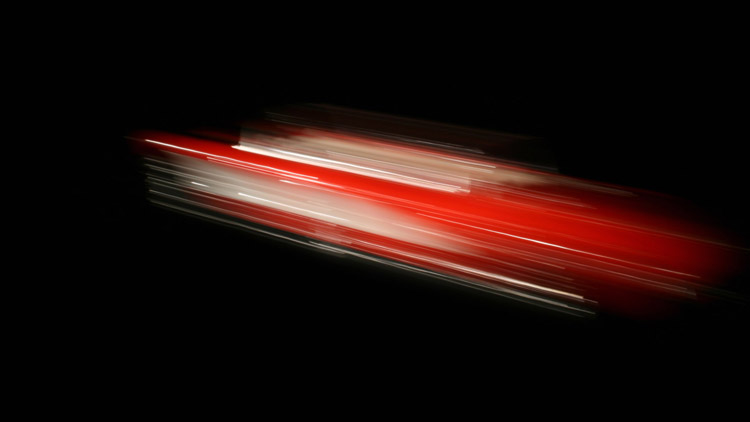
Dromosphäre / Thorsten Fleisch
CE: I remember the first time I saw Dromosphäre . The film was completely mesmerizing. I kept trying to figure out how the images were produced ; they looked totally computer generated. I remember the stupendous dissonance I felt as you slowly revealed how the images were created using analogue means. In the time it takes the shutter to open and close, a toy car is displaced by a specific distance, thus creating the illusion of movement. E ach frame of the film represents a movement over the time. In other words, each frame of the film does not represent a specific place in time. Do you feel this film supports the idea that the experience of Now is separated from place?
TF: Well, my idea was that of Einsteinian space-time. In Gestalt (SD 2003/HD 2008), I worked with four-dimensional geometry and almost everybody was telling me that time is the fourth dimension. However, time isn’t the only thing that can be added to the three spatial dimensions. In fact, Gestalt doesn’t explore time as the fourth dimension. It explores a fourth spatial dimension that is not possible in reality, but that is mathematically possible.
With Dromosphäre, I thought it would be interesting to examine visual possibilities of four-dimensional space-time. That was my starting point. At first I experimented with moving the camera perpendicular to the shutter to see the room in space-time mode.[3] This wasn’t as exciting as I thought it would be. What was exciting was when I moved an object in front of the camera with the shutter open and then surround the object with the same single frame using a long exposure technique. It then became about the phenomenon of speed. I also thought about how matter is actually generated by speed. Consider how electrons orbit around a nucleus. Their mass is incredibly small; however, once rotated they take on a spinning mass. Consider the gyroscopic exercise tool. It becomes difficult to move since it is rotating quickly on the inside. I tried to convey this idea at the end of Dromosphäre. Through the use of superimpositions I tried to make the object look like an atom. Of course there are also cinematic implications; that is, the paradox of creating a moving image created with still frames. In fact, this film turns that notion inside out by showing the stillness of a moving object.
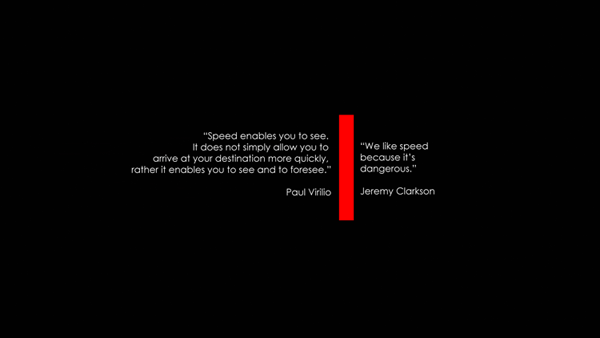
Dromosphäre / Thorsten Fleisch
CE: In the film, you juxtapose quotes by the BBC television personality Jeremy Clarkson and the theorist Paul Virilio. Was this intended to be tongue-in-cheek, or are you suggesting that the ever-increasing speed at which we receive information is actually dangerous?
TF: It is intended to be a bit tongue-in-cheek. I wanted to contrast the academic world with pop culture. One is potentially complicated and the other is inherently easy to grasp but also totally generalizing. This is how the world works, as one can see in the political realm. The popular solutions are always the simplified ones, a result of black-and-white thinking. The general idea was to juxtapose two contrasting perspectives on speed. Neither represents my view on the topic. I’m not much of a philosopher nor am I into generalizations. However, I do enjoy reading Virilio and watching Top Gear, the BBC series that features Clarkson.
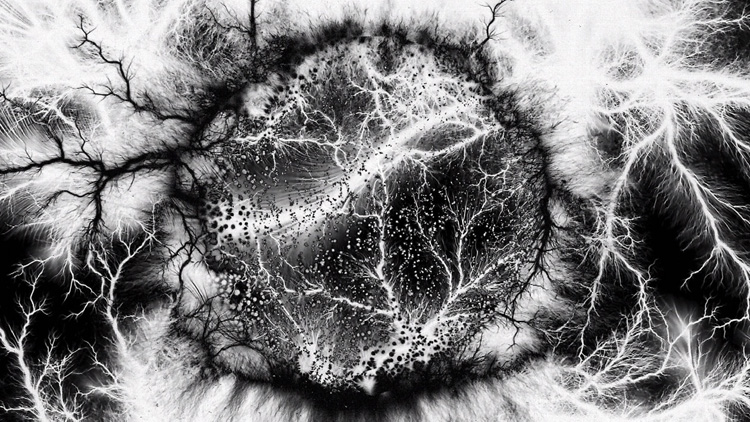
Energie! / Thorsten Fleisch
CE: Your film Energie! (2007), ironically, also looks computer generated. The film is, in essence, contact printed energy! I personally like how the sparks resemble trees. In the titles you made for Enter the Void , you expanded on this technique by conducting electricity through metal letters. Do you plan on going any further with it?
TF: I think I’m through with it for now. I’m much more interested in going further into the concepts developed in Dromosphäre. That is, creating more complex time-space arrangements. I am worried that if I do more with electrophotography it might become too much of a gimmick. At one point I thought it would be great to make more electrophotographs for galleries but I’m not really connected to that world. It would be easy enough to find a small gallery to exhibit with in Berlin, but I don't find that art scene very interesting. Discovering the electrophotographs of Hiroshi Sugimoto, which aren’t exactly the same but similar enough, has also discouraged me from continuing in that direction. I’m more interested pursuing the animation technique that I applied in Energie!
CE: Many of your works have a basis in mathematics. How did you become interested in that field? Have you received any formal training?
TF: Nothing beyond my high school education. My brother is a computer scientist and we sometimes talk about mathematics. He even helped me with some of the coding on Gestalt. In the early 90s, when I was still in school, we worked with the Mandelbrot fractal[4] and I would take single shots of the monitor with a super 8 camera. The result was a bit too dark, though.
I have always liked mathematics. I find the logic can be very soothing but I’m also excited by the chaos in it. A lot of modern mathematics is really weird and esoteric.
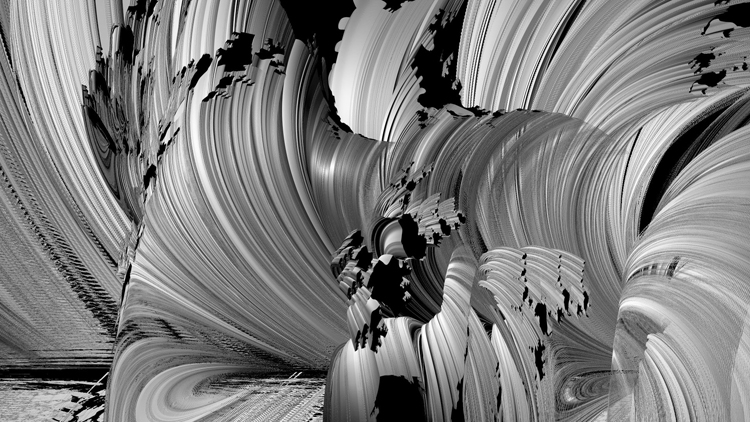
Gestalt / Thorsten Fleisch
CE: In Gestalt, you create a gorgeous escape time fractal using the function
xn+1= xnp - c
and Quat, a program which generates quaternionic fractals. Can you explain this program a bit?
TF: First, it is probably important to explain the concept of a quaternion number and of an escape time fractal. A quaternion number is equivalent to a complex number, which consists of two parts: one real, one imaginary. A typical imaginary number can be written as a + bi, where a and b are real numbers, and i2 = -1. Analogously, a quaternion number consists of four parts, a real part and three imaginary parts. A typical quaternion number can be written as a + bi + cj + dk where a, b, c and d are real numbers and i2 = j2 = k2 = ijk = -1. Hence, four dimensions.
When generating an escape time fractal we basically pose the question for each point in the plane: does the iterative sequence–determined by our function and the point–escape or not? Mathematically speaking, if the sequence heads towards infinity then it has escaped; otherwise, the sequence will converge towards a fixed point or oscillates periodically between some values and does not escape. If the sequence has not escaped, the point is included; if the sequence has escaped, the point is not included. The Mandelbrot fractal is an example of an escape time fractal that uses complex numbers.
Basically Quat generates escape time fractals using quaternion numbers and the function given. I can’t say that I totally understand all of this but I do find these types of objects very interesting and strange. It’s fairly esoteric, maybe not for a mathematician, but definitely for me.[5]
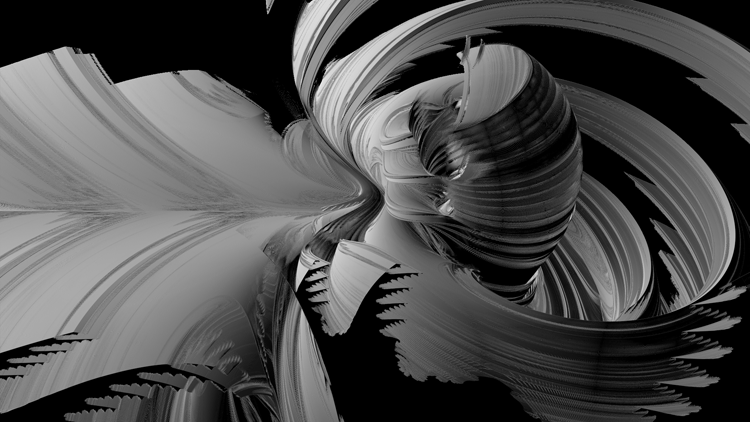
Gestalt / Thorsten Fleisch
CE: That is a wonderful explanation, keeping in mind your exploration of four spatial dimensions. The images from Gestalt really help to clarify what you’re talking about. Given that this work is so computationally intensive, how long did it take you to render each image and how long did it take to complete the film?
TF: At first I experimented with a very low resolution to orient myself in this unfamiliar world. I spent a lot of time rendering short sequences with small changes to the parameters for each image. I think it took about a year of just exploring and collecting sequences I liked. I then selected the ones that I thought would fit together to create a dramatic arc and rendered them in a higher resolution (720x576). That probably took 8-10 months of rendering. Back then, I was stealing a lot of computer time from my family and friends. At the time, my computer had a 1 Ghz CPU. I later re-rendered the film in HD resolution (1920x1080), which only took about three months, using a quad-core CPU that I over-clocked to 3 Ghz. It was very satisfying to push that CPU to the limit. There were always four instances of the program rendering at the same time. I would never have been able to complete the HD version of this film in 2003 with my 1Ghz computer.
CE: Do you have any interest in using software like Processing or Pure Data?
TF: My friend Jens Thiele, who did the music for Energie!, showed me Pure Data several years ago but I never did much with it. Processing has been on my radar for a while and I just recently decided to get a bit more into it. For my new film Green Screen I thought it would be helpful to work with Processing [an open source programming language and environment for creating images, animations, and interactions] since some of the image manipulation I need to do is very time consuming with Photoshop. With Processing I can try out certain effects faster to find out what works and what doesn’t. With Photoshop it takes hours to do the same image manipulation on each of the individual frames; with ProcessingI can serialize the process. On the other hand, I find it hard to think about the coding aspect of what I want to do. I hope I won’t lose my interest in learning the language; it’s a great tool with many possibilities.
CE: What more can you say about Green Screen?
TF: In Green Screen, I am using green screen technology to explore optical illusions of movement within abstract imagery similar to the techniques used in Energie! I am trying to explore these techniques further and use more complex visual illusions. I call this technique ghost animation. It is animation that you only barely notice within abstract textures. That is, the shapes stick out of the textures once there is movement. This might be analogous to the Magic Eye 3D stereograms, not in the sense of the 3D effect that is achieved but in the way the abstract texture is used to conceal the underlying image. At the moment, I only have this figured out for very simple forms. When the forms get too complex it becomes more difficult to recognize them.
CE: This sounds wonderful. I am looking forward to it!
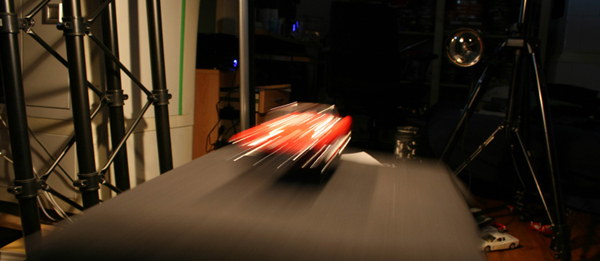 Dromosphäre / Thorsten Fleisch
Dromosphäre / Thorsten Fleisch
Thorsten Fleisch – Filmography
Dromosphäre (Dromosphere), 2010, HD, 10:06
Wound Footage, 2003/2009, DV, 6:02
Gestalt, 2003/2008 , HD, 5:20
Der Dosenjob (The Can Job), 2008, HD, 2:28
Energie!, 2007, HD, 5:03
Kosmos, 2004, 16mm, 5:11
Friendly Fire, 2003, 16mm, 7:40
Más Fuerte, 2003, 16mm & DV, 16:00
Hautnah (Skinflick), 2002, 16mm, 7:30
Videohaut ( Videoskin), 2001, DV, 5:00
Silver Screen, 2000, 16mm, 5:00
Superbitmapping, 2000, 16mm, 2:30
Blutrausch ( Bloodlust), 1998, 16mm, 4:20
K.I.L.L. – Kinetic Image Laboratory / Lobotomy, 1998, VHS, 3:30
Permutation, 1998, Super 8, 0:33
Kamerazerfetzer (Camera Annihilator), 1998, Super 8, 2:28
Flexcam, 1998, Super 8, 2:03
Fick das System ( Fuck the System), 1998, Super 8, 0:55
Skin Sketches, 1998, Super 8, 3:58
Generation X -> X2, 1997, Super 8, 0:33
Expanded Cinema Works
Instructions For Films – Peristaltic Fantasy, 2007, idea for a film on a white card
Der verbotene Film (Forbidden Film), 2006, 16mm
Möbius Filmschleife ( Möbius Filmloop), 2003, 16mm
ZUSE, 2002, 35mm
Feuer Frei (Open Fire), 1998, 16mm
Der Antifilm ( The Anti-Movie), 1997, Super 8
1. Stan Brakhage, “Metaphors of Vision,” Film Culture no. 20, fall 1963, p. 21.
2. Self Improvement (Clint Enns, 2010). See http://vimeo.com/12103065
3. To view the set-up see http://fleischfilm.com/?p=149
4. The Mandelbrot fractal is an extremely well-known fractal discovered and popularized by Benoît Mandelbrot. It is one of the best known examples of visual mathematics and there are many programs used to generate it. An online, real-time Mandelbrot fractal generator can be found here: http://mandelbrot.collettivamente.com/
5. Online documentarion for Quat is available here: http://www.physcip.uni-stuttgart.de/phy11733/doc/ quat-us.html. It can also be downloaded at http://www.physcip.uni-stuttgart.de/phy11733/index_e.html
Published December 1, 2010
ABOUT THE AUTHOR
Clint Enns is a Winnipeg-based video artist and filmmaker. His work deals primarily with moving images created with broken and/or outdated technologies and has screened nationally and internationally in installations, festival screenings, alternative spaces, and mircocinemas. Enns holds a Master's degree in Mathematics from the University of Manitoba. His interests include model theory of rings and modules, structuralist film, destructuralist video, and mathematics in art.
INCITE Journal of Experimental Media
Back and Forth
